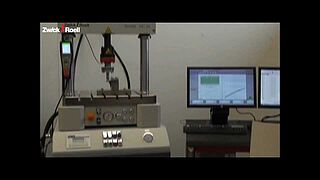Fatigue Tests on the Tibial Plateau of Artificial Knee Joints to ASTM F1800 and ISO 14879
As the human knee must withstand high compressive loads, as well as loads generated by movement, the tibial plateau of artificial knee joints are tested by being subjected to up to 10 million load cycles. The fatigue test to ASTM F1800 and ISO 14879 is performed under pulsating compressive loading applied to one end of the tibial plateau.
One half of the tibial plateau is gripped in a clamping device and additionally secured with, for example, bone cement. The unsupported half of the tibial plateau is subjected to physiologically representative loads applied via a specified compression die. ISO 21536 and ASTM F2083 specify a test load of 900 N, however the load can be much higher.


Test fixture with integrated knee joint
Benefits of the ZwickRoell text fixture for the tibial plateau of artificial knee joints:
- Easy operation and complete fulfillment of the requirements of ASTM F1800 – Standard Practice for Cyclic Fatigue Testing of Metal Tibial Tray Components of Total Knee Joint Replacements, and ISO 14879 – Determination of endurance properties of knee tibial trays.
- Universal test fixture for various tibial plateau geometries
